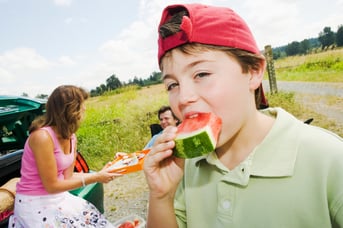You get the required amount of sleep but all day long you still feel you’re in second gear. You’ve tried caffeine and sugar to help pep you up, but nothing seems to work. Luckily, there are some healthy tweaks you can do to help you feel energized all day long. Read below and chat with your doctor on how these nutrition, lifestyle or supplement changes may help you.
 Make Your Meals Count
Make Your Meals Count
You may think that a Frappuccino, an energy drink or a smoothie are the best things to consume to start the day. This may be the very reason why you’re feeling so tired mid-afternoon! Instead start your day with a meal filled with a lean protein, some fiber rich carbohydrates and healthy fats. Did you know that the afternoon sluggish feeling is related to a naturally occurring dip in your circadian rhythm? But having a low fiber, high carb breakfast will amplify that sluggish feeling all day long.
Another place we get into trouble is with our lunch. A large plate of pasta and a soda is sure to leave you feeling tired. The best way to figure out what works for your body is to observe how you feel 30 minutes and two hours after you eat. If you feel a dip in your energy, start playing with your protein, fat and carbohydrate ratio. To start with, try eating a meal that is made up of 45% carbohydrates (vegetables, and whole grain), 10%-35% protein (fish, chicken, lentils) and 20%-35% fat (avocados, nuts, seeds). By incorporating this formula, it will keep your blood sugar in better balance, help prevent that sleepy feeling you get after you eat and improve your energy levels.
Sleep
Problems falling asleep, tossing and turning and not being able to fall back asleep are obvious reasons you may be feeling a lack of energy. The best way to combat these things is to forgo that 3pm caffeine boost and to get in sync with your circadian rhythm. Our natural sleep/wake cycles do best if we go to bed around 10pm and keep a consistent bedtime.
Not being able to go back to sleep after waking up in the middle of the night can be frustrating. It’s almost as if someone has turned on a light in your brain. My favorite two techniques to combat this are: meditation and writing out what’s stressing you out before going to bed.
Stress and Adrenal Fatigue
Being in a consistent stressed-out state can cause you to develop a symptom called Adrenal fatigue. Adrenal fatigue robs you of energy, prevents you from getting a good night sleep and causes you to crave sweet or salty foods. Meditation, yoga and apoptogenic herbs can help combat adrenal fatigue. These healing herbs can help balance the body’s natural response to handle stress by supporting the adrenal system.
The best adaptogen herbs to help boost energy are: ashwagandha, rhodiola, holy basil and ginseng.
B Vitamins
Known as the “energy vitamins”. Having low levels of B vitamins, especially B12, can cause you to feel fatigued. Ironically, having enough B vitamins in your diet also helps with getting a good night sleep. B vitamins are found in foods such as eggs, salmon, beef, chicken, avocado, leafy greens, milk, yogurt and legumes.
Exercise
When you’re feeling tired, the last thing you may want to do is exercise. Exercise is a great way to get your blood moving, which helps your heart and lungs work more efficiency, which in turn gives you more energy. On top of this, exercise increases your endorphin levels. Increased endorphin levels help make you feel good, decrease the feeling of being stressed out and helps you sleep better.
Moderate exercise is all you need. Contact one of your NIFS representatives to learn additional techniques to have more energy or to have them design a customized, and energizing work for you.


 With inflation at a 40 year high and grocery costs up close to 11% when
With inflation at a 40 year high and grocery costs up close to 11% when Are you hoping to start meal prepping to allow for more time during the weeknights? Meal-prepping is a great way to ensure you are eating a well-balanced diet, even when you are on a time crunch throughout the week. It can be a daunting and time-consuming task at first, so here are a few tips to get you started.
Are you hoping to start meal prepping to allow for more time during the weeknights? Meal-prepping is a great way to ensure you are eating a well-balanced diet, even when you are on a time crunch throughout the week. It can be a daunting and time-consuming task at first, so here are a few tips to get you started.

 Whether you are traveling for business or for pleasure it typically means most meals are eaten out or on the go. This can be challenging to make the most balanced choices and keeping your eating on the right track. You want to try foods special to that region, you are busy and grabbing the first thing that sounds good, you don’t have access to a grocery store for more fresh foods can all be challenges while traveling.
Whether you are traveling for business or for pleasure it typically means most meals are eaten out or on the go. This can be challenging to make the most balanced choices and keeping your eating on the right track. You want to try foods special to that region, you are busy and grabbing the first thing that sounds good, you don’t have access to a grocery store for more fresh foods can all be challenges while traveling.
 Many people don’t know where to start when eating healthier. Here are eight tips to help you eating smarter. You don’t need to do them all, but by incorporating just a couple of changes each week, you will find yourself on a path to better health in no time!
Many people don’t know where to start when eating healthier. Here are eight tips to help you eating smarter. You don’t need to do them all, but by incorporating just a couple of changes each week, you will find yourself on a path to better health in no time! Vitamin D…almost all of the 600 IU that are recommended daily. The canned tuna and sardines are an inexpensive way to get in seafood, heart healthy omega 3’s and 150 IU of Vitamin D per serving. Another bonus is the long shelf life if you haven’t been to the grocery store to get fresh protein choices.
Vitamin D…almost all of the 600 IU that are recommended daily. The canned tuna and sardines are an inexpensive way to get in seafood, heart healthy omega 3’s and 150 IU of Vitamin D per serving. Another bonus is the long shelf life if you haven’t been to the grocery store to get fresh protein choices.
 It’s that time of the year again: football season. With every year comes a clean slate for each team. Rosters are changed, stars have yet to emerge, and the underdog team is nowhere close to being discovered. With the changes the football season brings, have you ever considered your dietary habits for the season? Similar to the new football season ahead, do you plan to change your eating or drinking habits for football Sunday?
It’s that time of the year again: football season. With every year comes a clean slate for each team. Rosters are changed, stars have yet to emerge, and the underdog team is nowhere close to being discovered. With the changes the football season brings, have you ever considered your dietary habits for the season? Similar to the new football season ahead, do you plan to change your eating or drinking habits for football Sunday?
 Carbohydrate sounds like such a dirty word these days. It’s that word that makes everyone cringe or slightly panic, but why? There’s the myth that all carbohydrates are bad, giving people the distorted thought that cutting carbs will help you lose that extra weight you might be carrying. The truth is that not every single carbohydrate is bad. The category of carbohydrates is very broad, so I am going to break it down for you.
Carbohydrate sounds like such a dirty word these days. It’s that word that makes everyone cringe or slightly panic, but why? There’s the myth that all carbohydrates are bad, giving people the distorted thought that cutting carbs will help you lose that extra weight you might be carrying. The truth is that not every single carbohydrate is bad. The category of carbohydrates is very broad, so I am going to break it down for you.  The countdown begins as the league’s top-ranked defense of the Seattle face the leading Denver offense on February 2nd. With the matchup set, there are no clear favorites this year, making this the must see game of the season. For football fans this means hours of what hopefully is a really great game. For food fans, this means a delicious feast to be shared among family and friends. If you are neither, well at least you can get a good laugh during commercials.
The countdown begins as the league’s top-ranked defense of the Seattle face the leading Denver offense on February 2nd. With the matchup set, there are no clear favorites this year, making this the must see game of the season. For football fans this means hours of what hopefully is a really great game. For food fans, this means a delicious feast to be shared among family and friends. If you are neither, well at least you can get a good laugh during commercials.